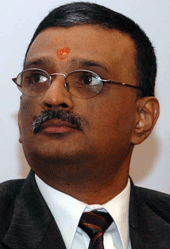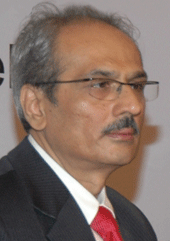After The Boom, The
Bang
 After
the boom, the bang: Exports rose by an astounding 36.2 percent up to
$16.9 billion from $12.4 billion last year (the April 2010 figure was
the sixth straight month of growth in exports after 13 consecutive months
of decline), and freight forwarders have been having a hard time as
cargo fares continue mounting skywards. After
the boom, the bang: Exports rose by an astounding 36.2 percent up to
$16.9 billion from $12.4 billion last year (the April 2010 figure was
the sixth straight month of growth in exports after 13 consecutive months
of decline), and freight forwarders have been having a hard time as
cargo fares continue mounting skywards.
Many exporters who had resigned themselves
to the rising rates were floored in May 2010 when fares touched an all-time
high.
The chorus against airlines charging more
has risen to a crescendo. According to J.Krishnan, (right) President
of the country’s apex body of freight forwarders, the Air Cargo
Agents Association of India (ACAAI) and one of the top forwarders based
in the south Indian city of Chennai, the rise has been continuous. “The
aircargo rates started rising some months ago and though everything
else seems to have stabilized, the rates have not come down,”
he told this correspondent.
 His
colleague in Mumbai and Vice President of ACAAI, Bharat Thakkar, (left)
echoed his sentiments. Talking to ACNFT, he pointed out that
aircargo rates were the highest in May. “What is more damaging
is that many carriers had been levying express rates for ordinary cargo.
We feel that this situation will continue for a month more—until
the high demand peters off following the monsoon in the country. In
fact, the pressure still exists in Mumbai, Delhi and Chennai…
” His
colleague in Mumbai and Vice President of ACAAI, Bharat Thakkar, (left)
echoed his sentiments. Talking to ACNFT, he pointed out that
aircargo rates were the highest in May. “What is more damaging
is that many carriers had been levying express rates for ordinary cargo.
We feel that this situation will continue for a month more—until
the high demand peters off following the monsoon in the country. In
fact, the pressure still exists in Mumbai, Delhi and Chennai…
”
The highest freight rates, according to
ACAAI, were those to Europe. The rates from Chennai, for example, were
around 30 percent higher. While on the one hand, airlines and forwarders
were still trying to recover from the “ash” backlash, on
the other hand there was high demand. This had led most European carriers
to fly with full loads. Many freight forwarders said that a number of
shipments were being dispatched to southern Europe for onward movement
to central and northern Europe by rail or road.
Perhaps the worst hit has been perishable
exporters. The country sends out around 300 metric tons of fruits and
vegetables daily, of which 150 metric tons are by air. Exports to Europe,
for example, are worth around $10 billion a year.  To
add to their problems, most carriers look at perishable goods as low
margin cargo and often do not even lift them. According to Ajai Sahai,
Director General of Federation of Indian Export Organizations, the airlines
should desist from exploiting the situation by increasing freight costs
to recover the losses. To
add to their problems, most carriers look at perishable goods as low
margin cargo and often do not even lift them. According to Ajai Sahai,
Director General of Federation of Indian Export Organizations, the airlines
should desist from exploiting the situation by increasing freight costs
to recover the losses.
Airline operators, however, maintain that
the rates are not high. Many carriers had lowered capacity when the
recession started. Even so, there was excess space, which led to low
cargo rates. Now, however, though the demand is high, rates have remained
more or less at the same levels they were five years ago, according
to Jay Shelat, (right) Jet Airways’ Vice President, Cargo. Shelat
believes that if has been a rise, it is due to the fuel hike—it
was $30 a barrel five years ago, but it is now $85. He also pointed
out that, despite the rising demand, export shipments were 15 percent
lower than in 2007-08.
The rates notwithstanding, the civil aviation
ministry has estimated the growth of the air cargo business in India
during 2011-2012 to be at 11.8 percent. In a recent statement issued
in Parliament by Praful Patel, Minister of Civil Aviation, the growth
in air cargo was approximately 5 percent in 2008-09. Barring any unfortunate
incidents, the future promises to be good for air cargo from India.
Tirthankar Ghosh
|



